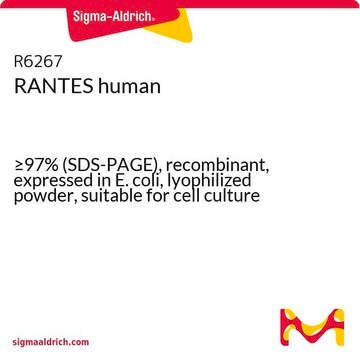SRP3269
RANTES human
Animal-component free, recombinant, expressed in E. coli, ≥98% (SDS-PAGE), ≥98% (HPLC)
Synonym(s):
CCL5, SIS-delta
Sign Into View Organizational & Contract Pricing
All Photos(1)
About This Item
UNSPSC Code:
12352200
NACRES:
NA.32
Recommended Products
biological source
human
recombinant
expressed in E. coli
assay
≥98% (HPLC)
≥98% (SDS-PAGE)
form
lyophilized
potency
1.0-10.0 ng/mL
mol wt
7.8 kDa
packaging
pkg of 20 μg
impurities
<0.1 EU/μg endotoxin, tested
color
white
UniProt accession no.
shipped in
wet ice
storage temp.
−20°C
Gene Information
human ... CCL5(6352)
General description
Regulated on activation, normal T cell expressed and secreted (RANTES) also known as C-C motif chemokine ligand 5 (CCL5) is encoded by the gene mapped to human chromosome 17. RANTES belongs to intercrine or chemokine family of proinflammatory basic polypeptides and is expressed by various hematopoietic and non-hematopoietic cell types involved in homing and migration of effector and memory T cells during acute infections. Recombinant human RANTES is a 7.8kDa protein containing 68 amino acid residues including the four highly conserved cysteine residues present in the CC chemokines.
Application
RANTES human has been used in following studies:
- In transmigration experiments to determine whether LFA-1 cross-linking could affect peripheral blood T lymphocytes (PBTL) migration in response to the chemokine RANTES.
- Luminol-dependent chemiluminescence assay to determine the effect of RANTES on reactive oxygen species (ROS) production by eosinophils.
Biochem/physiol Actions
Regulated on activation, normal T cell expressed and secreted (RANTES) is a chemoattractant towards monocytes, dendritic cells (DCs), memory T cells (CD4+/CD45RO), basophils, and eosinophils. The encoded chemokine protein functions as a ligand for CCR1, CCR3, and CCR5.1 RANTES inhibits the action of R5 strains of HIV-1 via blocking CCR5 receptor. The In1.1C variant of RANTES gene is linked with susceptibility to HIV-1 infection and disease progression. Hence, this can be used as a potent biomarker to determine the prognosis of HIV-1 infection.
Physical form
Lyophilized with no additives.
Reconstitution
Centrifuge the vial prior to opening. Reconstitute in water to a concentration of 0.1-1.0 mg/mL. Do not vortex. This solution can be stored at 2-8°C for up to 1 week. For extended storage, it is recommended to further dilute in a buffer containing a carrier protein (example 0.1% BSA) and store in working aliquots at -20°C to -80°C.
Storage Class
10 - Combustible liquids
wgk_germany
WGK 3
flash_point_f
Not applicable
flash_point_c
Not applicable
Certificates of Analysis (COA)
Search for Certificates of Analysis (COA) by entering the products Lot/Batch Number. Lot and Batch Numbers can be found on a product’s label following the words ‘Lot’ or ‘Batch’.
Already Own This Product?
Find documentation for the products that you have recently purchased in the Document Library.
Role of chemokine and cytokine polymorphisms in the progression of HIV-1 disease.
Mahajan SD
Biochemical and Biophysical Research Communications, 396(2), 348-352 (2010)
RANTES-activated human T lymphocytes. A role for phosphoinositide 3-kinase.
Turner L
Journal of Immunology, 155(5), 2437-2444 (1995)
J J Oppenheim et al.
Annual review of immunology, 9, 617-648 (1991-01-01)
A family consisting of at least ten distinct novel 8-10 kd cytokines has been identified over the past 12 years. These cytokines exhibit from 20 to 45% homology in amino acid sequence, are probably all basic heparin-binding polypeptides, and have
Upregulated response to chemokines in oxidative metabolism of eosinophils in asthma and allergic rhinitis.
Sannohe S
The European Respiratory Journal, 21(6), 925-931 (2003)
Inside the crawling T cell: leukocyte function-associated antigen-1 cross-linking is associated with microtubule-directed translocation of protein kinase C isoenzymes beta(I) and delta.
Volkov Y
Journal of Immunology, 161(12), 6487-6495 (1998)
Our team of scientists has experience in all areas of research including Life Science, Material Science, Chemical Synthesis, Chromatography, Analytical and many others.
Contact Technical Service








